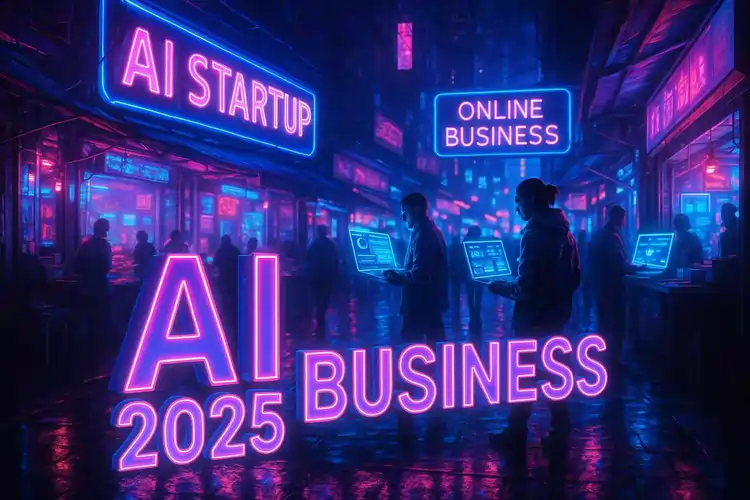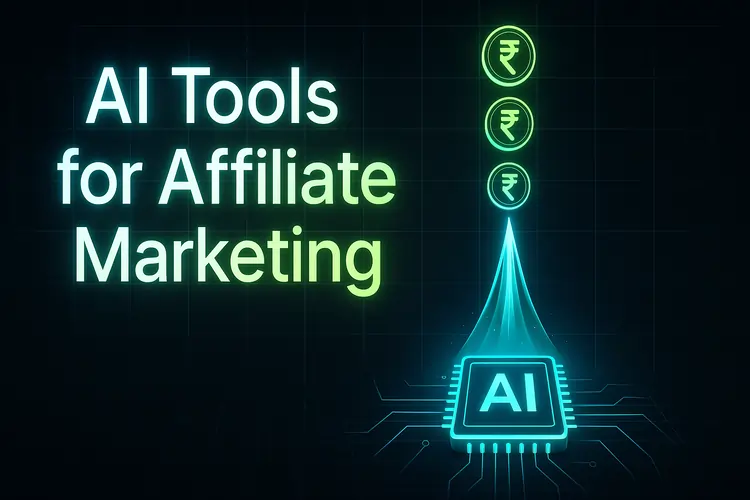Starting an AI-powered online business in 2025 is one of the fastest ways to achieve freedom, flexibility, and consistent income.
With the right AI tools and strategies, you can launch with minimal investment and scale globally in months — not years.
From building sales funnels that convert to automating customer support with AI, entrepreneurs are now blending creativity with automation to dominate entire niches. At The DM School, we’ve seen students use AI to launch digital products, coaching programs, and even full-service agencies in record time.
This guide will walk you through a proven, step-by-step process combining AI marketing, SERP intelligence, and business automation so your brand not only ranks on Google but also gets cited by AI tools like ChatGPT, Gemini, and Perplexity.
If you’re ready to make money with AI this year, you’re in the right place.

Step 1 — Build Your SERP Intelligence Layer
A SERP Intelligence Layer is your competitive radar.
It tracks where and how your business appears across Google, AI search engines, and SERP features like featured snippets and People Also Ask boxes.
Instead of only checking rankings, you also monitor whether AI tools like ChatGPT or Gemini are citing your content. This shift is vital for entrepreneurs using AI marketing to scale quickly in 2025.
For example, a business selling digital marketing services can identify high-value keywords already showing AI Overviews and create content designed to win those spots — ensuring visibility even when users don’t click through.
Reverse-engineer their structure, then create better, more proof-rich content.
Recommended tools include SERanking, Ahrefs with AI SERP tracking, and Google Search Console for organic insights. For campaign inspiration, study our case studies showing how brands grew visibility by combining keyword tracking with AI-specific monitoring.
Once your SERP Intelligence Layer is in place, you’ll have a clear map of opportunities — from content gaps to backlink prospects — making it easier to create a digital marketing strategy that wins both Google rankings and AI citations.
Step 2 — Define Your AI-First Business Model
Before building systems, decide exactly how your AI-powered business will make money. Choosing the right model ensures every tool, campaign, and strategy drives measurable revenue.
In 2025, top AI-first models include selling digital products, launching niche membership sites, providing marketing services, and building AI-driven SaaS tools.
Each can be started lean and scaled quickly with automation.
If you’re aiming for recurring income, pair a content-rich website with AI monetization strategies like affiliate programs, AI-curated courses, and automated lead generation funnels. Our ad process guide shows how to drive predictable traffic to any model.
AI gives you speed, but focus keeps you profitable.
Still unsure? Explore our business ideas library
or learn from real case studies where founders turned AI skills into thriving online ventures.
Step 3 — Build Your AI Tech Stack
Every AI-powered business runs on a stack of tools that automate creation, marketing, and sales. Choosing the right combination of AI tools can cut months of work down to days.
🧠 Generative AI
- ChatGPT – content & strategy
- Gemini – Google-integrated AI
- Claude – long-form reasoning
⚙️ Automation
- Make.com – workflows
- Zapier – app integrations
- Gupshup – WhatsApp automation
📊 Analytics & SEO
- GA4 + AI Insights
- Ahrefs/SERanking
- Notion AI – note-taking
At The DM School, we use this stack to build full-funnel systems that run on autopilot. See our AI marketing guide for full implementation.
Step 4 — Create AI-Optimized Content (SEO + AEO + GEO)
An AI-first content strategy blends SEO, Answer Engine Optimization (AEO), and Generative Engine Optimization (GEO).
Each plays a role in ranking on Google and being cited by AI tools.
SEO covers fundamentals like technical SEO, link structure, and keyword targeting.
AEO focuses on structuring short, high-quality answers to win snippets and PAA boxes.
GEO ensures your content is AI-ready with clear definitions, stats, and frameworks.
📍 SEO
- Keyword mapping & topical clusters
- Schema markup
- Internal linking
💬 AEO
- Q&A blocks under headings
- 40–50 word snippet answers
- Definition and list formats
⚙ GEO
- Entity-rich content
- Unique stats & case studies
- Modular, AI-readable sections
For example, our ChatGPT prompt library is designed for GEO — clear, modular prompts that AI can reuse. Our YouTube monetization guide
uses AEO principles to dominate snippet spots.
When creating content, align it with your marketing funnel. Top-of-funnel posts attract readers, mid-funnel guides nurture leads, and bottom-funnel assets convert with offers like free strategy calls.
Step 5 — Align with AI Surfaces
AI surfaces are places your brand appears without a click.
Think featured snippets, PAA, AI Overviews, Maps, and video carousels.
🔎 Text Surfaces
- Write 40–50 word answers under each H2.
- Use definition, list, and Q&A formats.
- Add schema where relevant: FAQ, HowTo, ItemList.
📍 Local & Media Surfaces
- Optimize for Maps with Local SEO.
- Target video carousels with YouTube content.
- Back claims with case studies and reviews.
Map each target surface to a page.
Then design that page for the surface first, not the blog.
That block wins snippets and AI Overviews.
Cover fundamentals with SEO basics and shore up technical SEO. Poor crawl or speed blocks AI citations.
Use entity signals and trust pages. Link from Google Partner advantages and your reviews hub to money pages.
Build topical depth with hub links. Use the AI hub at /category/ai/ and add practical assets like ChatGPT prompts.
For commercial intent, align surfaces with offers. Connect to services and add a clear book a call CTA.
Step 6 — Technical & Brand Readiness
Even the best AI strategy fails if your site has crawl issues, poor speed, or weak trust signals.
Technical and brand readiness ensures both Google and AI can understand, index, and cite your content.
⚙ Technical Essentials
- Pass the SEO audit checklist.
- Implement technical SEO best practices.
- Use schema for FAQ, HowTo, and Article.
- Enable HTTPS, lazy-load images, and optimize Core Web Vitals.
🏆 Brand Signals
- Show proof with case studies.
- Highlight Google Partner status.
- Build authority pages like About Us and Reviews.
- List official profiles on trusted platforms.
AI models pull from trustworthy sources.
Weak technical health or brand presence limits your inclusion in AI citations and SERP features.
This strengthens topical authority and trust signals for AI and search.
For local or service-driven businesses, integrate Local SEO with your brand readiness plan. Verified NAP data and map listings boost both human and AI trust.
If you need expert execution, our SEO team can handle the technical overhaul while you focus on scaling your AI-first business.
Step 7 — Monitor, Iterate, Dominate
AI-first businesses win by staying ahead of algorithm shifts, SERP updates, and new AI surfaces.
Continuous monitoring and iteration keep your visibility and revenue growing.
Use your ad process and SEO audit checklist to create monthly review points. Check AI citations, snippet positions, and traffic patterns.
📊 Quarterly AI-SEO Review Plan
- Month 1: Content refresh — add stats, improve snippet blocks.
- Month 2: Link audit — strengthen internal links to proof pages.
- Month 3: AI surface tracking — compare to competitors, adjust targeting.
Leverage insights from Google Ads case studies to refine campaigns and reallocate budget to high-performing AI-driven channels.
Don’t just track rankings — monitor branded searches, click-through rates, and AI citations from tools like Perplexity or ChatGPT. Our SEO experts use this data to guide proactive optimizations.
This historical data reveals trends and missed opportunities.
Finally, set a recurring task to review your reviews and official profiles. Positive sentiment and verified profiles directly influence AI trust.
Case Study — From Zero to AI-Cited Authority in 90 Days
In early 2025, a coaching business approached The DM School with zero online presence and no prior SEO work. Their goal: rank for niche coaching terms and be cited by AI tools.
We started with a full SEO audit and technical fixes to remove crawl barriers. Next, we created a topical content hub linked from their main services page.
📈 90-Day Results
- 16 AI citations in Google AI Overviews.
- 5 featured snippet wins for money terms.
- Average position improvement from 48 → 8.
- Direct leads via booked calls doubled.
Key to success was aligning pages with AI surfaces, backed by proof pages like case studies and Google Partner SEO advantages.
entity-rich content, and trust pages from day one.
This transformation mirrors results from our Google Ads case studies, where strategic targeting and AI-optimized content delivered measurable wins within 3 months.
Common Mistakes to Avoid When Using AI to Start a Business
Many entrepreneurs fail with AI not because of the tools, but because of poor execution and strategy gaps.
Avoid these mistakes to protect your time, budget, and brand authority.
❌ Over-Reliance on AI
AI can’t replace human insight. Use it to accelerate, not automate blindly.
❌ Ignoring Technical SEO
Skipping technical SEO can block both Google and AI from finding your content.
❌ No Proof Pages
Without case studies and reviews, AI tools may ignore your brand.
Other pitfalls include poor content formatting, not targeting local search when relevant, and skipping competitor research before publishing.
SEO audit
and check it against your AI visibility goals.
For guidance on structuring AI-friendly campaigns, see our digital marketing strategy guide or speak to our SEO experts.
Final Action Plan — Launch Your AI-Powered Online Business in 2025
You now have the roadmap to start, scale, and dominate with an AI-first business.
Here’s your condensed action plan to execute over the next 90 days.
✅ 90-Day AI Business Launch Plan
- Choose your business model — product, service, or hybrid (business ideas).
- Set up your SERP Intelligence Layer to track AI and search visibility.
- Align goals with SEO audits and AI citation targets.
- Create AI-optimized content using proven prompts and snippet structures.
- Optimize for AI surfaces — snippets, PAA, AI Overviews, Local SEO (Local SEO services).
- Build technical trust with technical SEO and proof pages (case studies, reviews).
- Review, iterate, and improve monthly using your AI-SEO dashboard.
This is the same framework we’ve used to help brands in Bangalore, Mumbai,
and Hyderabad grow revenue and earn AI citations in weeks.
If you want expert help executing this plan, our SEO and AI marketing team
can handle the heavy lifting. Book your free strategy call today and launch your AI-powered online business with confidence.
Frequently Asked Questions (FAQ)
❓ Can I start an AI business with no experience?
Yes. Many students at The DM School have launched AI-powered businesses with zero tech background using no-code tools like Make.com, ChatGPT, and Canva AI.
❓ What are the best AI tools to start a business?
Top tools include ChatGPT, Gemini, Make.com, and Notion AI. We use them to automate funnels, content, and follow-ups.
❓ How much does it cost to start an AI business?
You can start for under ₹5,000/month using free tiers and low-cost tools. Most of our students launch with digital products, coaching, or service-based models that scale fast.


